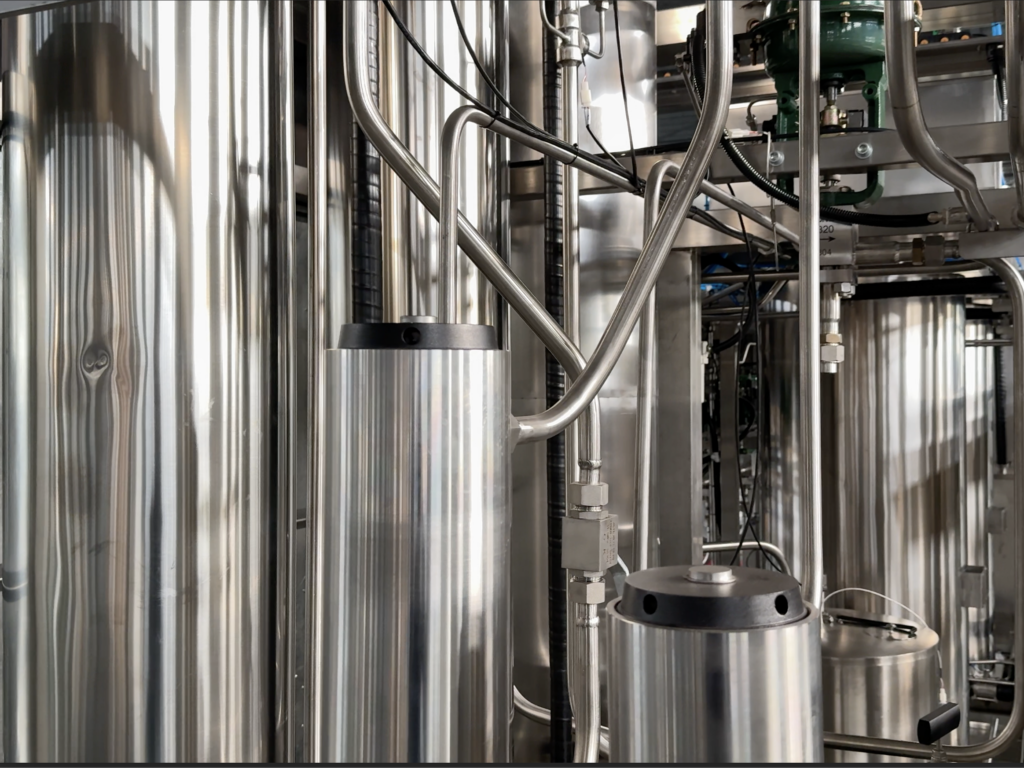1. What is Supercritical Carbon Dioxide (sCO₂)?
Understanding Supercritical CO₂
Supercritical carbon dioxide (sCO₂) is a unique phase of CO₂ that occurs when it is subjected to temperatures above 31.1°C (critical temperature) and pressures above 7.38 MPa (critical pressure). In this state, it behaves both like a gas and a liquid simultaneously. As a result, it possesses gas-like diffusivity, allowing it to penetrate materials easily, while also exhibiting liquid-like solvating power, making it an excellent solvent for various industrial applications.

Key Characteristics of Supercritical CO₂
- Low viscosity, enabling it to flow more easily than most liquids.
- Its high density is similar to that of liquids, which enhances its solvating capability.
- High diffusivity, allowing it to penetrate microscopic pores efficiently.
- Adjustable properties, as its behavior can be fine-tuned by changing temperature and pressure.
Therefore, these properties make supercritical CO₂ highly versatile, finding applications in extraction, carbon capture, energy production, and green chemistry.
2. Why is the Viscosity of Supercritical CO₂ Lower than That of Liquids?
Effect of Temperature on Viscosity
One of the most remarkable properties of sCO₂ is its exceptionally low viscosity. Compared to conventional liquids, such as water (0.89 mPa·s at 25°C), supercritical CO₂ has a viscosity of only 0.07 mPa·s, making it nearly 12 times lower.
Consequently, this low viscosity enables supercritical CO₂ to flow effortlessly through complex porous structures, which is particularly advantageous in applications like supercritical extraction, enhanced oil recovery (EOR), and CO₂-based cooling systems.
Advantages of Low Viscosity
- Enhanced penetration ability: It can easily infiltrate solid materials such as coffee beans and plant tissues, making it ideal for decaffeination and essential oil extraction.
- Improved diffusion rate: It significantly increases efficiency in supercritical fluid extraction (SFE) and carbon capture and storage (CCS).
- Energy efficiency: Since it flows with less resistance, it requires less energy for circulation, reducing operational costs.
In short, the lower the viscosity, the easier it is for CO₂ to transport substances efficiently, improving its effectiveness as an industrial fluid.
3. Why is the Density of Supercritical CO₂ Higher than That of Gases?
The Dependence of Density on Temperature and Pressure
Unlike gases, which expand freely, supercritical CO₂ maintains a relatively high density, similar to liquids. This is because as pressure increases, CO₂ molecules are forced closer together, making the fluid denser than gases but more mobile than traditional liquids.
For instance, at 40°C and 10 MPa, supercritical CO₂ has a density close to that of liquid CO₂. On the other hand, at 50°C and 7.5 MPa, its density decreases, behaving more like a gas. This adaptability makes sCO₂ a highly tunable solvent for industrial applications.
Industrial Applications of High-Density sCO₂
- Supercritical Fluid Extraction (SFE): The high density of sCO₂ allows it to dissolve target compounds effectively, making it ideal for extracting caffeine, essential oils, and pharmaceutical ingredients.
- Carbon Capture and Storage (CCS): The high-density property facilitates the compression and underground storage of CO₂, helping reduce global carbon emissions.
- Supercritical Reaction Engineering: Many chemical reactions benefit from the high solvent power and reaction efficiency of sCO₂, leading to greener and more efficient industrial processes.
Therefore, the ability to adjust its density by modifying pressure and temperature gives supercritical CO₂ a clear advantage over conventional solvents.
4. The Combined Effect of Viscosity and Density on Fluid Behavior
Performance Under High-Temperature and High-Pressure Conditions
Because supercritical CO₂ has both low viscosity and high density, it combines the best of both worlds: the ease of flow of a gas and the solvating power of a liquid. As a result, it is particularly effective in:
- Nanomaterial fabrication: It can penetrate nano-sized pores without damaging the structure, making it ideal for producing advanced materials.
- Green cleaning technologies: It replaces organic solvents in precision cleaning processes, such as removing contaminants from semiconductors and medical instruments.
- Enhanced oil recovery (EOR): Its ability to move easily through porous rock formations enables it to extract residual oil more efficiently than traditional methods.
In contrast to traditional solvents, which are often hazardous or inefficient, supercritical CO₂ offers a safer, cleaner, and more energy-efficient alternative.
5. Conclusion: Why is sCO₂ Key to Future Green Technologies?
Given its low viscosity, high density, and high diffusivity, supercritical CO₂ is transforming multiple industries. Moreover, its ability to function as an environmentally friendly solvent makes it a sustainable choice for applications in green chemistry, clean energy, and carbon reduction technologies.
As industries increasingly focus on carbon neutrality and sustainable development, the role of supercritical CO₂ will continue to expand, driving innovation in numerous fields.
Ultimately, supercritical CO₂ represents a breakthrough in fluid technology, offering unparalleled efficiency and environmental benefits.
Frequently Asked Questions (FAQ)
1. Is supercritical CO₂ a gas or a liquid?
Supercritical CO₂ is neither purely a gas nor a liquid. Instead, it exhibits gas-like diffusivity and liquid-like solvating power, allowing it to behave as a hybrid fluid.
2. Why does supercritical CO₂ have a lower viscosity than conventional liquids?
Because intermolecular forces are weaker in the supercritical state, sCO₂ flows more easily than traditional liquids like water or ethanol.
3. Is supercritical CO₂ environmentally friendly?
Yes! Unlike traditional organic solvents, supercritical CO₂ is non-toxic, residue-free, and recyclable, making it ideal for applications in food processing, pharmaceutical extraction, and eco-friendly cleaning technologies.
4. What are the main industrial applications of supercritical CO₂?
- Supercritical Fluid Extraction (SFE): Used for decaffeination, essential oil extraction, and pharmaceutical purification.
- Carbon Capture and Storage (CCS): Helps reduce carbon emissions and supports carbon neutrality initiatives.
- Nanotechnology and Material Science: Plays a crucial role in advanced material fabrication and micro-pore cleaning.
- Energy Industry: Applied in enhanced oil recovery (EOR) and supercritical CO₂ power cycles.